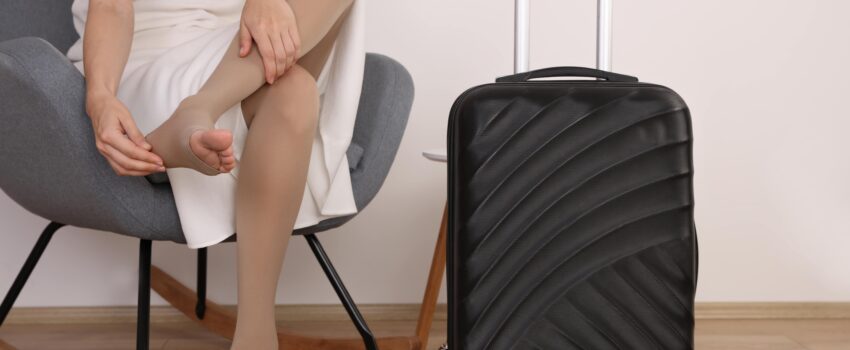Sitting for long periods, such as during a flight or road trip, can often worsen symptoms of varicose veins. It also increases the risk of blood clots, which is a serious complication of varicose veins and deep vein thrombosis (DVT).
Fortunately, there are ways to travel safely with varicose veins while reducing the risk of blood clots and leg pain. Here are vein health tips to follow when traveling and where to find Long Island varicose veins treatment.
What Are the Risks When Traveling With Varicose Veins?
Blood clots and pulmonary embolism (PE) are the two most serious concerns associated with traveling and varicose veins.
Any physical inactivity, such as standing or sitting for long periods, can slow blood flow and circulation. Staying active and elevating the legs is often essential to increasing circulation and avoiding complications of varicose veins.
In addition to blood clots and PE, the following symptoms of varicose veins may intensify when traveling:
- Increased pain in the legs
- Itching in the legs
- Feeling of heaviness in the legs
- Swelling in the legs
- Burning or throbbing sensation in the legs
What Are Essential Tips for Flying With Varicose Veins?
Practicing vein care is essential while traveling with varicose veins, as it can reduce or prevent any pain and discomfort, as well as blood clot formation and PE.
Here are some practical vein health tips to follow when flying:
- Get up to walk around at least once an hour.
- Do frequent exercises such as leg or knee lifts, ankle circles, and toe raises when sitting down.
- Elevate the legs, if possible.
- Massage the calf muscles to increase blood flow to the legs.
- Practice deep breathing to increase blood flow to the chest.
- Avoiding sitting with legs crossed.
- Change sitting positions frequently.
- Drink plenty of water to stay hydrated and stabilize blood pressure.
- Avoid using alcohol and drugs (such as sleeping pills) that may interfere with circulation.
- Wear compression stockings to increase circulation.
- Wear comfortable, loose-fitting clothing to promote blood flow.
- Avoid eating foods high in salt and sodium to reduce swelling in the legs.
- Keep the bedroom cool at night if traveling to a place with warm weather, which can often exacerbate symptoms of varicose veins.
- Soak the legs in a cold bath after spending long periods in warm or hot weather.
- Seek treatment from a vein specialist before traveling.
Varicose Veins Treatments That Offer Minimal Downtime
A variety of treatments are available for varicose veins that produce minimal or no downtime, including endovenous laser ablation (EVLA) and ultrasound-guided sclerotherapy. EVLA and sclerotherapy can be performed within a few days or weeks before traveling to eliminate varicose veins, along with the symptoms and complications that go with them.
EVLA
During EVLA, a tiny laser fiber is inserted directly into the varicose vein, which heats up the vein and causes it to close. Blood flow is redirected to nearby healthy veins. This treatment produces minimal downtime, and usual activities can be resumed the next day.
Ultrasound-Guided Sclerotherapy
During ultrasound-guided sclerotherapy, a needle is guided carefully into the varicose vein, which is then injected with a foam solution that causes it to seal shut. Like EVLA, sclerotherapy produces minimal downtime and can eliminate the vein and its symptoms.
Seeing a Vein Specialist
Meeting with a vein specialist and treating varicose veins before traveling long distances can often eliminate many worries and complications associated with living with a vein condition.
North Shore Vein Center offers treatments for varicose veins, including sclerotherapy and endovenous laser ablation. Contact North Shore Vein Center today at (516) 869-8346 to request an initial vein consultation and learn more about your treatment options.

